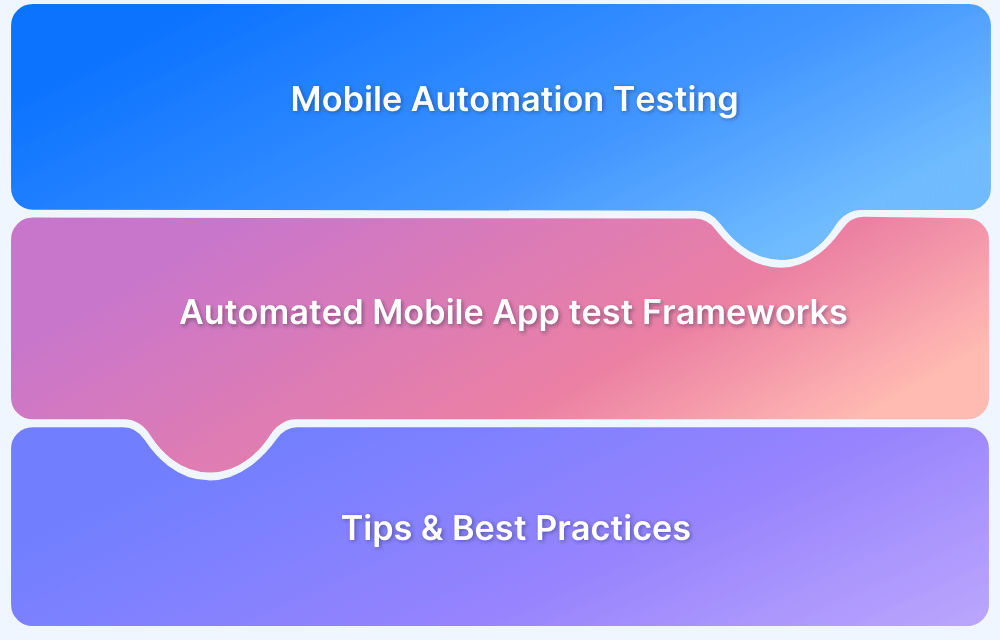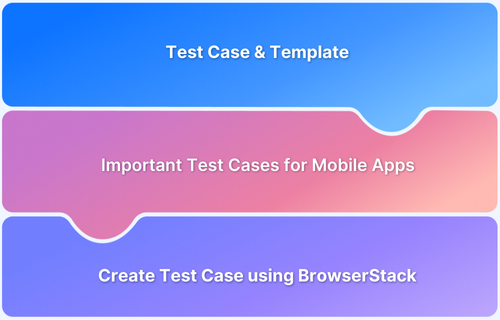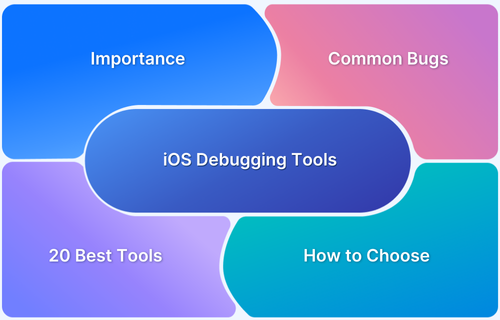Maestro testing provides a framework for automated UI testing of mobile apps. With Maestro, React Native apps can be tested across Android and iOS devices without complex configuration or fragile scripts.
Overview
What is Maestro Framework?
Maestro is an open-source framework designed for mobile app UI automation testing. It enables reliable testing of app interactions, supports multiple platforms, and uses human-readable YAML scripts to define test flows.
Why Choose Maestro for React Native Testing?
- Time-saving: Automates repetitive UI validation across platforms
- Improved quality: Detects issues early in development cycles
- Faster feedback: Provides quick insights during CI/CD runs
- Enhanced user trust: Ensures stable and consistent app experiences on real devices
Key Aspects of Using Maestro with React Native
- Cross-platform testing: Write once and execute across both Android and iOS devices.
- YAML-based test flows: Define readable and maintainable steps for UI automation.
- Simulating user interaction: Perform taps, swipes, text input, and gesture validations seamlessly.
- Integration with React Native: Supports native modules and common patterns in React Native apps.
- Simplified setup and execution: Minimal configuration required to start running tests on real devices or emulators.
How to Use Maestro for React Native Testing
- Set up the framework: Install Maestro using package managers or direct download, and connect it to Android and iOS environments.
- Write YAML test flows: Define steps such as taps, swipes, text inputs, and navigations in a human-readable format.
- Run tests locally: Execute flows on emulators or connected real devices to validate app behavior during development.
- Integrate with CI/CD pipelines: Add Maestro commands into build pipelines for automated regression testing.
- Analyze results: Review logs and outputs to quickly identify issues and refine flows for better reliability.
This article explains how to test React Native apps efficiently using Maestro.
What is Maestro Framework?
Maestro is an open-source automation framework designed to test mobile app UIs reliably on real devices. Unlike traditional mobile testing tools, it does not rely on emulators or fragile selectors. It interprets UI components directly from the app’s rendering layer, which reduces flakiness and improves stability.
Maestro uses YAML scripts to define test flows. Each step corresponds to an interaction or assertion, making test scripts human-readable while maintaining the rigor required for complex workflows. Its architecture supports parallel execution on multiple devices, enabling efficient cross-platform testing for React Native apps.
How Does Maestro Support React Native UI Testing?
Maestro automates React Native UI testing by interacting directly with app components and views. It abstracts platform-specific differences and simulates real user behavior across both Android and iOS.
Here are some more reasons to use Maestro for React Native UI testing.
- Precise element identification: Targets components using accessibility labels, text, or view hierarchy. Avoids fragile selectors like XPath or CSS, which break easily with UI changes.
Read More: Top 8 React Native UI Components in 2025
- Dynamic content handling: Automatically waits for asynchronous rendering, animations, and state updates before performing actions. Ensures tests do not fail due to timing issues.
- Complex gesture simulation: Supports taps, long presses, swipes, scrolls, and multi-touch gestures. Enables testing of interactive elements exactly as a real user would.
- Structured test flows: YAML-based scripts allow branching, conditional logic, loops, and assertions. Supports full user journeys, from app launch to complex workflows.
- Cross-platform execution: Executes the same flows on Android and iOS without rewriting scripts. Handles platform-specific differences internally to maintain consistency.
- CI/CD readiness: Integrates with pipelines to automate test execution, monitor results, and capture failures in real time. Improves feedback loops and reduces manual testing effort.
Read More: How to Setup an Effective CI/CD Pipeline
Why Choose Maestro for React Native Testing?
Maestro provides a robust framework for testing React Native apps. It interacts directly with app components to ensure reliable, stable, and maintainable test flows.
- Stable Tests with Less Maintenance: Reduces failures caused by minor UI changes, lowering the cost of maintaining test suites.
- Reusable Test Flows: Single flows can cover multiple scenarios or apps, saving development time and avoiding duplicate effort.
- Accurate User Simulation: Captures real gestures and interactions, producing results that reflect actual user behavior.
- Faster Feedback Loops: Automated execution highlights regressions early, allowing teams to fix issues before releases.
Read More: How to improve DevOps Feedback Loop
- Scalable Testing: Supports larger test suites and multiple devices without increasing complexity for testers.
Maestro vs Other React Native Testing Tools
Maestro stands out for its reliability and simplicity when testing React Native apps. Unlike Detox, Appium, and Jest, it interacts directly with UI components and works seamlessly on real devices.
| Feature | Maestro | Detox | Appium | Jest + React Native Testing Library |
| Platform support | Android and iOS, same flows | Android and iOS | Android and iOS | Mainly JavaScript logic, limited real-device UI testing |
| Element targeting | Accessibility labels, text, view hierarchy | Native selectors, can be brittle | XPath, class names, IDs | Component-level queries, no gestures |
| UI gestures | Tap, swipe, scroll, multi-touch | Tap, swipe, limited multi-touch | Tap, swipe, scroll | Not supported |
| Dynamic content handling | Waits for async rendering, animations, and state updates automatically | Manual waits often needed | Manual waits or retries needed | Not designed for dynamic UI |
| Test script readability | YAML-based, human-readable | JavaScript | Java, JavaScript, or Python | JavaScript, component-focused |
| CI/CD integration | Built-in support for pipelines | Supports CI/CD | Supports CI/CD | Limited to unit/integration pipelines |
Installing Maestro for React Native Projects
Before testing can begin, Maestro must be installed and your environment verified. This ensures the CLI and dependencies are ready to run tests on Android and iOS devices.
Step 1: Install Maestro CLI
To start, install the Maestro command-line interface. On macOS, the easiest method is Homebrew:
brew install maestro
Linux users should download and run the official installer from the Maestro website. After installation, confirm it is installed correctly by running:
maestro –version
Step 2: Verify Environment Requirements
Maestro relies on certain system components to run tests successfully. Ensure that Node.js version 16 or higher is installed. For Android, verify that Java, the Android SDK, and the ANDROID_HOME environment variable are correctly set. For iOS, confirm that Xcode and its command-line tools are installed.
Step 3: Initialize Maestro in the Project
Next, set up Maestro within your React Native project. Navigate to your project directory and run:
maestro init
This generates the necessary configuration files and a default test flow template.
Step 4: Install Project Dependencies
Ensure all dependencies are available for testing by running:
npm install
# or
yarn install
Step 5: Verify Setup
Finally, run a sanity check to confirm that the installation, environment, and connected devices are ready:
maestro doctor
This command will highlight any issues with configuration, dependencies, or device connectivity before you start writing tests.
Setting Up React Native Apps for Maestro Testing
Before writing tests, the React Native app itself must be prepared so that Maestro can interact reliably with UI components. Proper setup ensures elements are identifiable, gestures work correctly, and dynamic content doesn’t cause flaky tests.
Step 1: Add Accessibility Identifiers
Assign accessibilityLabel or testID to all interactive components, such as buttons, inputs, and lists. This allows Maestro to locate elements reliably across both Android and iOS.
Step 2: Ensure Predictable UI State
Avoid rendering components conditionally without placeholders. This ensures that Maestro waits correctly for elements to appear before performing actions, reducing test failures.
Step 3: Handle Dynamic Content
Wrap asynchronous or animated elements in React.Suspense or use loading indicators. This allows tests to wait for content to fully render before interactions.
Step 4: Maintain Consistent Component Hierarchy
Keep the view hierarchy predictable and avoid deeply nested or dynamically swapped components when possible. A consistent structure minimizes selector failures.
Step 5: Enable Debug Logging
Add console logs or Maestro-compatible debug output for key state changes. This helps trace failures and understand why a test might fail.
Step 6: Test Gestures on Real Devices
Before writing full test flows, verify taps, swipes, scrolls, and other gestures on actual devices. This ensures interactions behave as expected and are accurately simulated during automated testing.
Creating Your First Maestro Test Flow
Once the app is prepared and Maestro is installed, you can create your first test flow. A test flow defines a sequence of actions, validations, and user interactions to verify that the app behaves as expected. Maestro uses YAML scripts to make these flows readable and maintainable.
Step 1: Create a New Flow File
In your project directory, create a YAML file for the test flow. For example:
touch first_test_flow.yml
This file will contain all the actions and assertions for your test scenario.
Step 2: Define App Launch
Start the test flow by specifying the app launch:
app: your.app.bundle.identifiersteps:
– launch
This ensures the app starts in a clean state before interactions begin.
Step 3: Add User Interactions
Include actions like tapping buttons, typing text, or scrolling:
– tap: “loginButton” – type: “usernameInput” text: “tester@example.com”
– type: “passwordInput” text: “securepassword”
– tap: “submitButton”
Use the accessibilityLabel or testID defined in the app components for element references.
Step 4: Add Assertions
Verify that expected elements or messages appear after actions:
– assert: “welcomeMessage” text: “Welcome, Tester”
This ensures the app responds correctly to the inputs and interactions.
Step 5: Run the Test Flow
Execute the flow using the CLI:
maestro run first_test_flow.yml
Observe real-time results on the connected device. Any failures will be highlighted in the output.
Step 6: Debug and Iterate
If any step fails, check debug logs, element identifiers, and dynamic content handling. Update the YAML flow and rerun until the test passes reliably.
Essential Maestro Commands for React Native
Maestro provides a set of CLI commands that testers rely on to manage projects, execute test flows, monitor results, and troubleshoot issues. Knowing these commands ensures smooth setup, efficient test execution, and reliable debugging during React Native UI testing.
| Command | Syntax | Description |
| Verify Installation | maestro –version | Confirms that the Maestro CLI is installed and accessible on your system. |
| Initialize Project | maestro init | Sets up Maestro configuration files and generates a sample test flow in your project. |
| Run Test Flow | maestro run | Executes a specific YAML test flow on connected devices. Replace with your flow file name. |
| List Connected Devices | maestro devices | Displays all devices currently available for testing, including real devices and simulators/emulators. |
| Check Environment | maestro doctor | Validates configuration, dependencies, and device connectivity. Highlights any setup issues. |
| View Test Logs | maestro logs | Shows detailed logs of a test flow run, helping identify failed steps or errors. |
| Dry Run a Flow | maestro run –dry-run | Performs a simulation of the test flow without executing actions on devices. Useful for validation. |
| Validate YAML | maestro validate | Checks the YAML syntax and structure of your test flow to prevent errors before execution. |
| Stop Running Flow | maestro stop | Stops a currently running test flow on connected devices. Useful for long or stuck tests. |
Advanced Maestro Testing Techniques
Once basic flows are running reliably, advanced techniques help handle complex scenarios, improve test coverage, and reduce maintenance. These strategies allow testers to automate intricate user interactions, dynamic content, and conditional logic in React Native apps.
- Conditional Actions: Use conditional logic in YAML to perform steps based on the UI state. This allows flows to adapt dynamically to different app conditions without breaking.
- Loops for Repetitive Actions: Automate repeated interactions such as scrolling through lists, performing multiple logins, or tapping multiple items. Loops reduce duplication and simplify maintenance.
- Handling Dynamic Content: Wait for elements that load asynchronously or animate before interacting. This prevents test failures caused by timing issues and ensures stability.
- Multi-Device Testing: Run flows across multiple devices simultaneously to verify cross-platform consistency. Maestro allows targeting several devices in parallel to catch platform-specific issues.
Read More: How to perform Cross Device Testing
- Advanced Assertions: Verify multiple UI states or conditions in a single step. For example, check that an element is visible and has the correct text simultaneously.
- Debugging and Logging: Use detailed logging to trace failures, verify state changes, and analyze UI behavior during test execution. This improves troubleshooting efficiency.
Also Read: How to Debug React Code: Tools and Tips
Handling React Native Specific Scenarios
React Native apps often include asynchronous rendering, animations, dynamic lists, and platform-specific behaviors that can break tests if not handled correctly. Maestro provides strategies to address these challenges for reliable automation.
- Asynchronous Component Loading: Use wait steps to ensure elements appear before interacting. This prevents test failures caused by slow-loading components. For example, waiting for a loading spinner to disappear before tapping the next button.
- Animations and Transitions: Delay actions until animations complete. Maestro handles many transitions automatically, but explicit waits improve reliability and reduce flakiness.
- FlatList/ScrollView Handling: Use swipe or scroll commands to interact with off-screen items. Combine these with assertions to verify that the correct element is visible.
- Platform-Specific Differences: Handle Android vs iOS behaviors using conditional logic in YAML. This ensures consistent flows across platforms without duplicating test code.
- Network and Data Handling: For screens dependent on API responses, incorporate waits or test mocks to ensure that the UI is ready before performing actions.
Why Use BrowserStack with Maestro Testing
Maestro tests run on BrowserStack real devices to validate React Native apps across multiple OS versions and screen sizes. This ensures interactions, gestures, and UI behavior match real user experiences.
Here are some key benefits of running Maestro tests with BrowserStack.
- Real Device Cloud: Execute flows on a wide range of Android and iOS devices without maintaining physical hardware.
- Parallel Testing: Run multiple Maestro flows on different devices at the same time to reduce total testing time.
- Detailed Debugging: Access logs, screenshots, and video recordings for each test run to quickly identify issues.
- Local App Testing: Test apps hosted behind firewalls or on local servers with BrowserStack Local.
- CI/CD Integration: Automate test execution in pipelines to catch regressions early and maintain release quality.
Conclusion
Maestro provides a simple yet powerful way to automate React Native UI testing. By preparing apps correctly, using accessibility identifiers, and handling dynamic content, testers can create reliable and maintainable test flows.
Running Maestro tests on BrowserStack real devices ensures accurate validation across multiple platforms and devices. Parallel execution, detailed logs, and CI/CD integration make testing faster, more scalable, and easier to debug.







